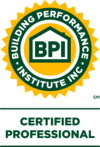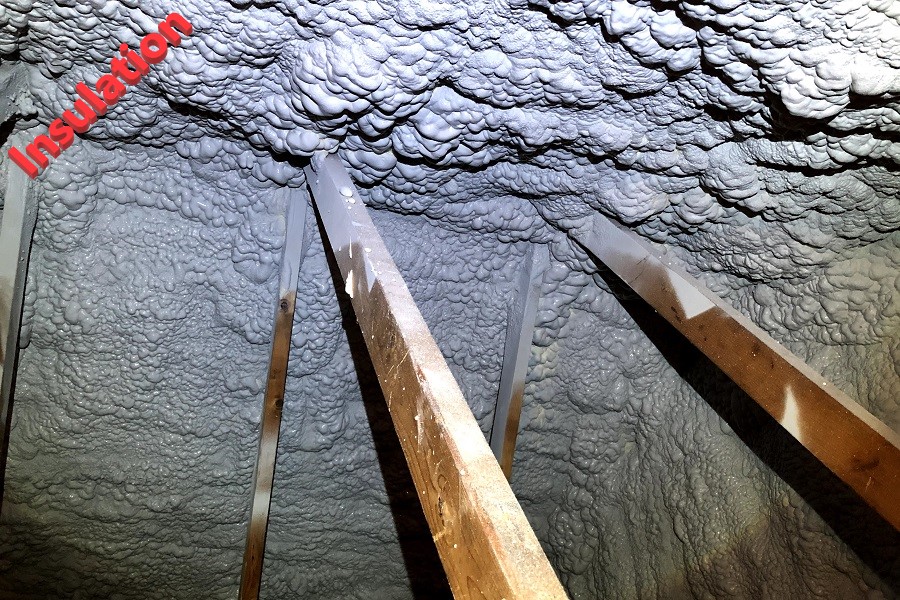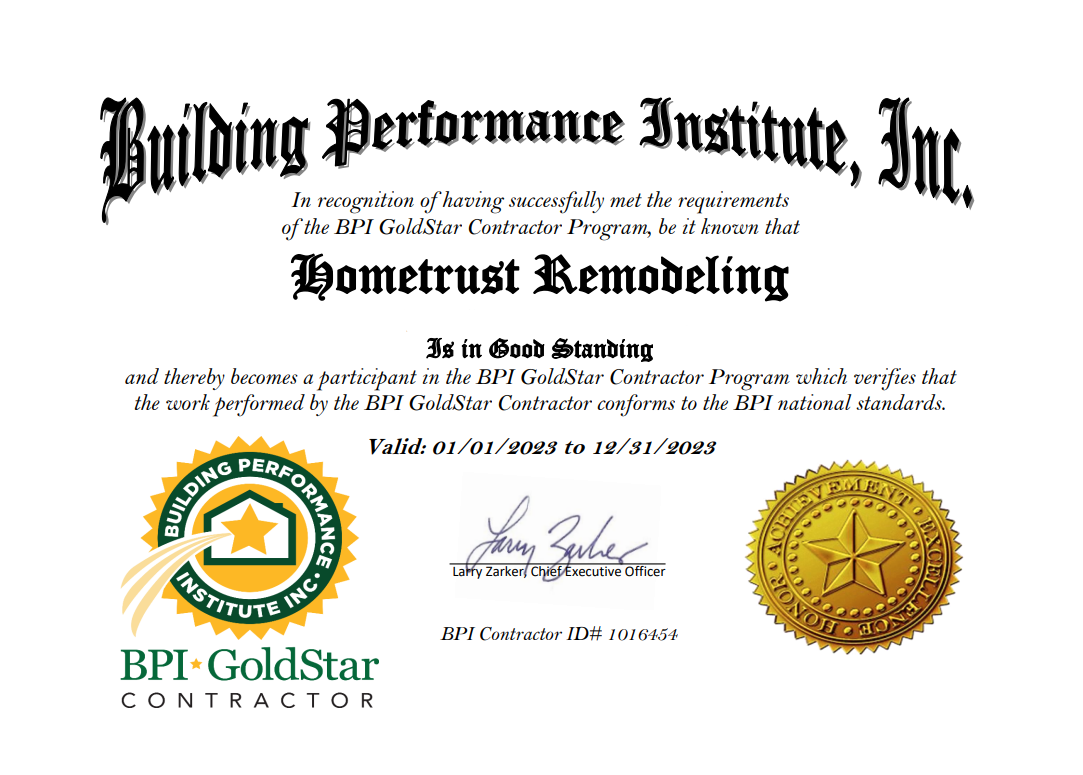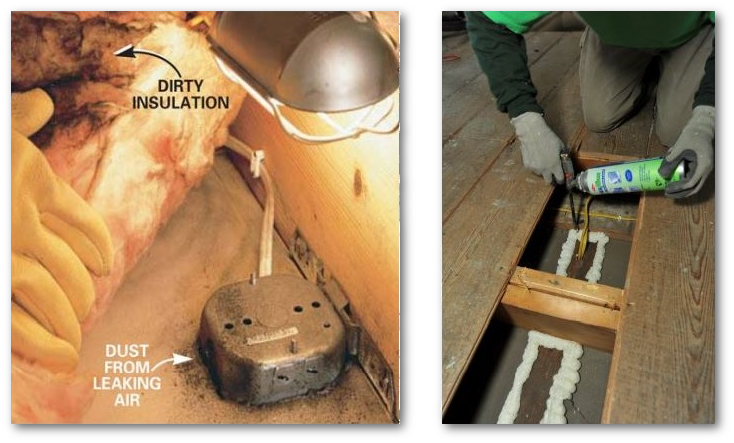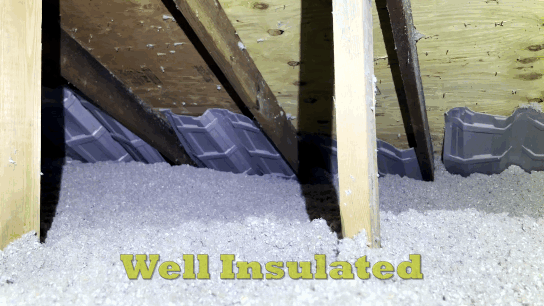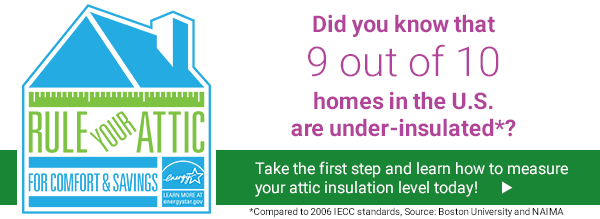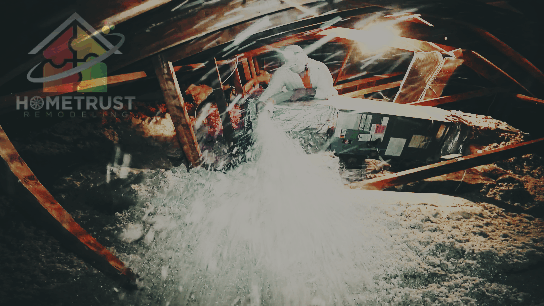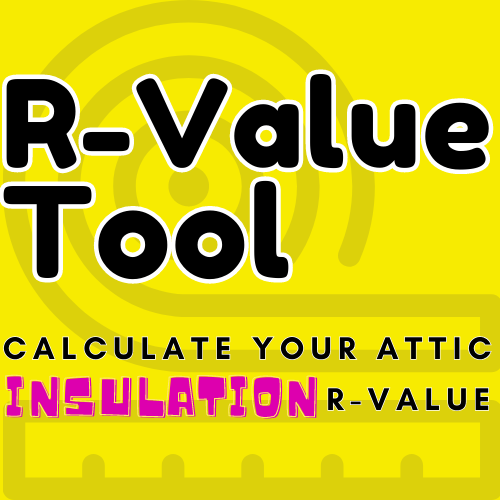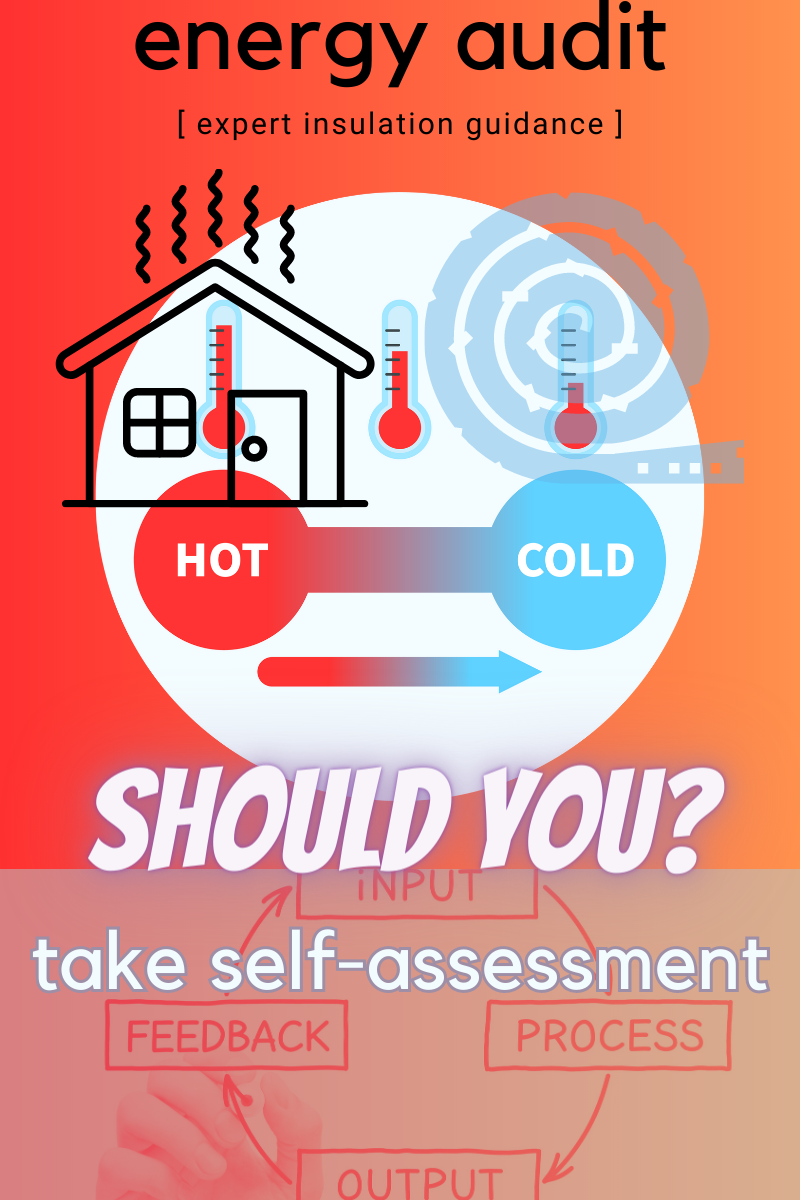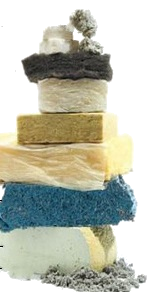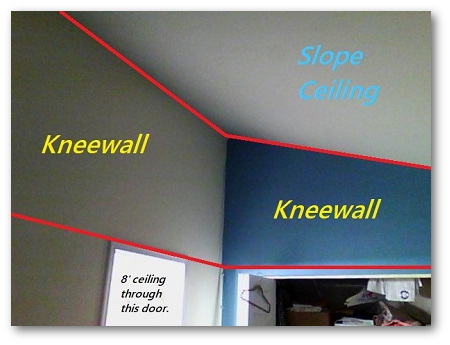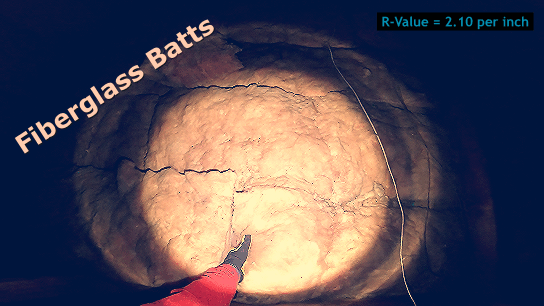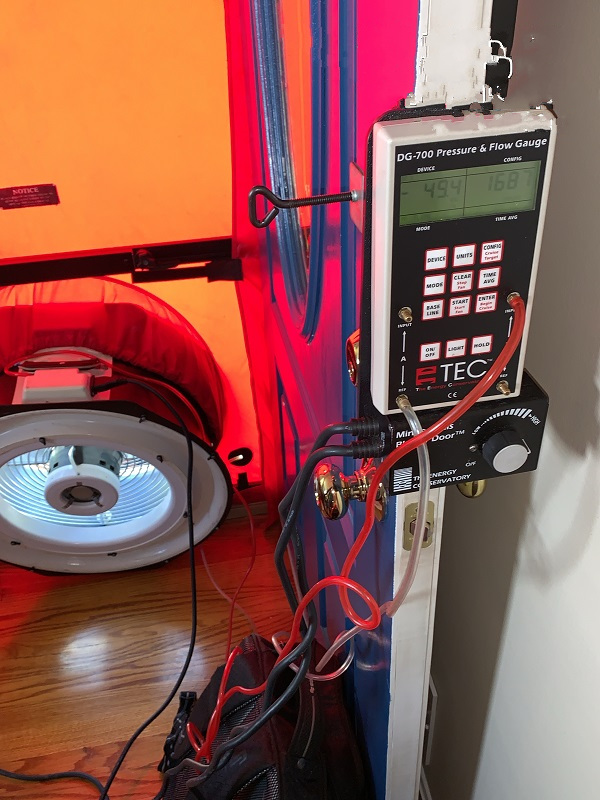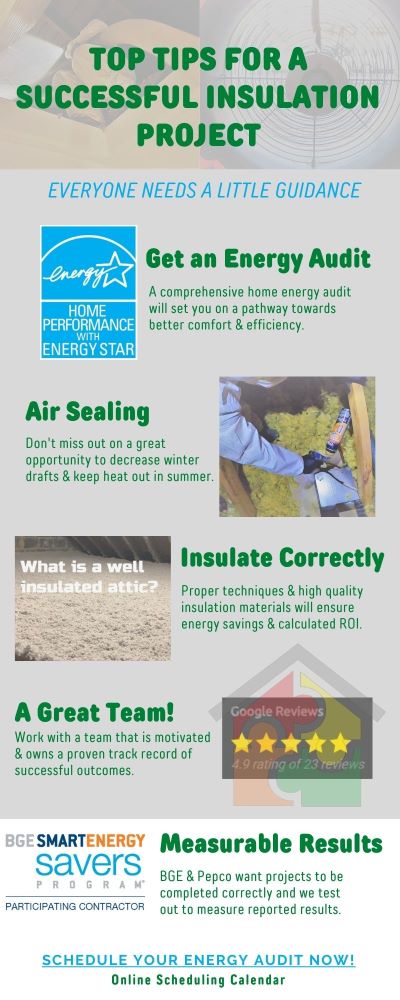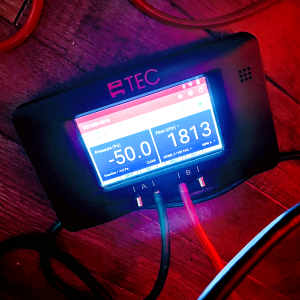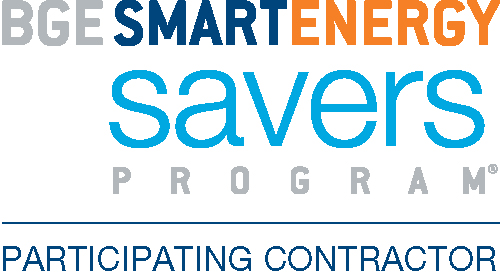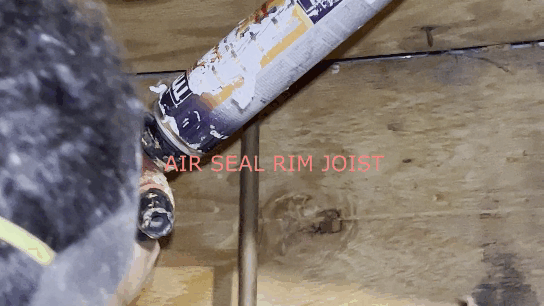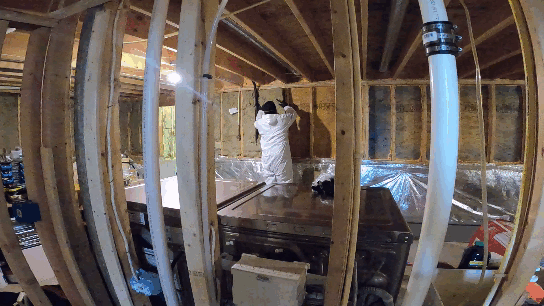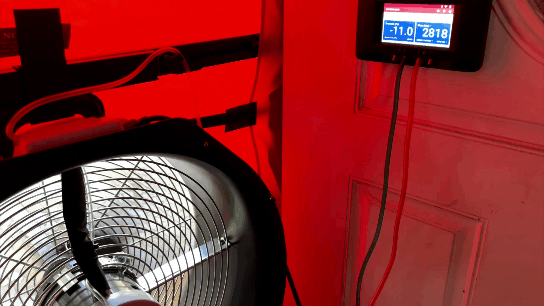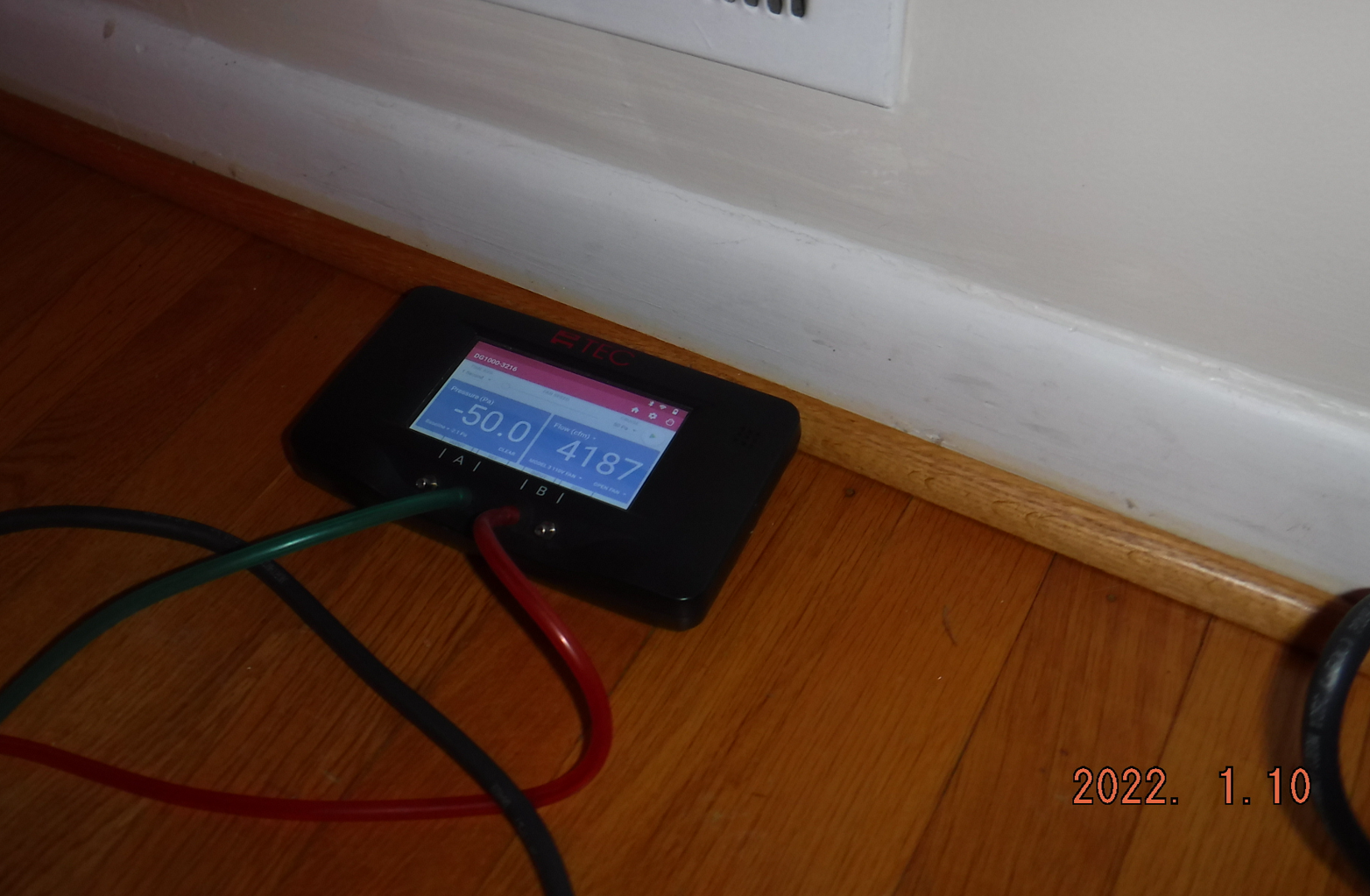Residential Comfort & Energy EfficiencyMonday, February 03 2025
Often times homeowners don't know what a Pepco energy audit is or how it can actually help. For starters, a Pepco energy audit can help you avoid choosing the wrong solution to a problem around your home. An energy audit through Pepco is a good place to start a home improvement priority list. Take the important step of scheduling your Pepco energy audit as soon as you can! Monday, February 03 2025
Often times homeowners don't know what a BGE energy audit is or how it can actually help. For starters, a BGE energy audit can help you avoid choosing the wrong solution to a problem. An energy audit through BGE is a good place to start a home improvement priority list. Take the important step of scheduling your BGE energy audit as soon as you can! Friday, June 07 2024
This article explores the different contractors available for this task and why a home performance contractor might be your best bet. Types of Contractors Who Replace Bathroom Exhaust FansUnderstanding the roles and capabilities of different contractors is essential in making the right choice for replacing your bathroom exhaust fan. Home Performance Contractors Overview: Home performance contractors evaluate and improve your home's efficiency and comfort. They take a holistic approach to ensure that the fan integrates seamlessly with your home’s ventilation, insulation, and energy systems. Strengths: They provide a comprehensive service, considering how the fan impacts your home’s air quality and energy efficiency. Their expertise in building science allows them to optimize the installation beyond just the mechanical aspects. Services: Hometrust Remodeling, for example, not only replaces bathroom exhaust fans but also evaluates where the fan terminates, ensuring optimal performance. We consider insulation and an airtight installation to prevent air leakage and energy loss. HVAC Contractors Overview: HVAC (Heating, Ventilation, and Air Conditioning) contractors are skilled in managing the mechanical aspects of heating and cooling systems, including ventilation. Strengths: They excel at ensuring proper airflow and can effectively address ventilation systems and ductwork issues. Weaknesses: However, their focus is typically narrow, often overlooking the broader impacts on energy efficiency and indoor air quality. They might not address the insulation and sealing around the fan, which are crucial for preventing moisture problems and maintaining energy efficiency. Electricians Overview: Electricians are essential for ensuring bathroom fans' safe and code-compliant electrical connection. Strengths: Their expertise is handling electrical wiring and installations, ensuring that everything meets safety standards. Weaknesses: Electricians may lack the specialized knowledge required for proper venting and integration with the home's overall ventilation system. They often do not consider the fan's implications for home performance or energy efficiency.
General Contractors or Handyman Services Overview: General contractors and handymen offer a wide range of home improvement services, including installing bathroom exhaust fans. Strengths: They are versatile and can handle various aspects of the installation, from mechanical to minor electrical work. Weaknesses: These contractors may not have specialized ventilation or energy efficiency knowledge. Their installations might miss critical elements like proper duct insulation and air sealing, leading to potential issues with moisture and energy inefficiencies. Why Choose a Home Performance Contractor?Home performance contractors have unique skills and knowledge, making them the ideal choice for replacing bathroom exhaust fans. Comprehensive Home Assessment Detailed Analysis: Home performance contractors thoroughly assess your home’s ventilation and insulation systems. They ensure the new fan fits and enhances your home’s efficiency and comfort. Preventive Approach: By considering how the fan interacts with the entire house, they can identify and prevent potential issues, such as moisture buildup in the attic or improper airflow.
Building Science Expertise Informed Installation: These contractors apply building science principles to ensure the fan is correctly installed, and the surrounding areas are properly insulated and sealed. This prevents energy loss and enhances the fan's effectiveness. Holistic Integration: They understand the importance of a tight building envelope and the role of ventilation in maintaining a healthy indoor environment. This knowledge helps them integrate the fan seamlessly into the home’s systems. Quality Assurance and Follow-Up Thorough Testing: After installation, home performance contractors perform detailed testing to ensure the fan operates efficiently and does not introduce air leaks. They measure the airflow and inspect the installation to confirm everything is functioning as expected. Post-Installation Support: They often provide follow-up visits to check the fan’s performance and address any issues, ensuring long-term satisfaction and performance. Integration with Other Home Systems Energy Efficiency Focus: Home performance contractors look at the big picture, considering how the new fan will impact your home’s energy usage. They can recommend improvements like air sealing or duct insulation to enhance efficiency. Optimized Solutions: Ensuring that all systems work harmoniously helps maintain optimal indoor air quality and comfort levels throughout your home. Choosing the Right Contractor for Your NeedsSelecting the appropriate contractor for your bathroom exhaust fan replacement depends on your needs and the project's scope.
YouTube Playlist: Highlights of a Home Performance Bath Fan Install
When replacing a bathroom exhaust fan, consider the unique benefits of hiring a home performance contractor. Their holistic approach, expertise in building science, and commitment to quality assurance make them the ideal choice for ensuring your new fan enhances your home’s comfort, efficiency, and air quality. For homeowners in Maryland, Hometrust Remodeling offers specialized services that provide lasting benefits and peace of mind. For expert bathroom exhaust fan replacement and comprehensive home performance services in Maryland, contact Hometrust Remodeling today. Schedule an assessment and discover how they can improve your home’s efficiency and comfort. Monday, June 03 2024
Solving the Problem of High Energy Bills and Uncomfortable HomesAre you a Maryland homeowner frustrated with high energy bills and uncomfortable indoor temperatures? If so, you're not alone. Many homeowners in Maryland are missing air sealing and insulation, which can lead to drafts, inconsistent heating and cooling, and, ultimately, a less comfortable living environment. Unfortunately, that does not stop the Utility bill from regularly flowing in... At Hometrust Remodeling, we understand these challenges through years of hands-on experience. We have spent hours listening to homeowners across the region and identifying the sources of their problems. Patterns begin to emerge, and we use the experience to help you create a more energy-efficient and comfortable home, reducing your energy bills and enhancing your quality of life. As a leading insulation contractor in Maryland, we educate you on how your home's parts work together. We assist you in making well-informed decisions using building science principles and modern insulation techniques.
Schedule Your Audit Today for Immediate ReliefWe know that dealing with insulation issues can be overwhelming, so we offer a straightforward solution: a comprehensive home energy audit. This audit is the first step toward identifying the specific insulation problems in your home. With just a click, you can schedule an audit and start your journey towards a more efficient and comfortable home. The audit costs only $100, less than it costs to have the refrigerator repair person show up! Our online booking system is easy to use, allowing you to schedule an energy audit at your convenience. You've Found the Right Place for Insulation SolutionsIf you're reading this, you're concerned about your home's insulation and seeking a reliable solution. You've come to the right place. Hometrust Remodeling is the leading choice for Maryland insulation contractors. We specialize in understanding Maryland homeowners' unique challenges and providing tailored solutions. With unique guidance from Building Science techniques, you're not just getting an insulation estimate — you're getting a trained expert dedicated to balancing your home's comfort, efficiency, and indoor air quality.
Imagine a Home Free from Insulation Problems Imagine a home where drafts are a thing of the past, rooms maintain a consistent temperature year-round, and energy bills don't rise as sharply. With diagnostics and our expert insulation services, this vision can become your reality. No more struggling with high energy costs or uncomfortable living conditions. Instead, you can enjoy a home that is both cozy and cost-effective, providing you with peace of mind and a better quality of life. This is what you can expect when you work with the premier Maryland insulation contractors at Hometrust Remodeling.
Comprehensive Insulation Services Tailored to Your NeedsAt Hometrust Remodeling, we provide comprehensive insulation services to address your home's needs. Our process begins with a detailed home energy audit, using advanced diagnostic equipment to identify areas where your home is losing energy. This allows us to pinpoint precisely where insulation improvements are needed. We inspect:
Once we've identified the problem areas, we provide targeted insulation solutions that enhance your home's energy efficiency. Whether we install new or improve existing insulation, we aim to ensure your home performs at its best. As leading Maryland insulation contractors, we are committed to delivering top-notch services that make a real difference. What Sets Us Apart from Other Insulation ContractorsWith a background in exterior remodeling, Hometrust Remodeling can provide a comprehensive assessment. We can give a "deep field" view of your home's overall performance, including window evaluations, roof condition, gutter effectiveness, and advice on siding and doors. With over 20 years of experience, extensive training, and industry certifications, we bring unmatched knowledge to every project. We pride ourselves on hands-on involvement in all aspects of the service process, ensuring that every detail is handled with care and precision. Our approach is rooted in building science principles and modern techniques, allowing us to deliver effective and long-lasting results. When you choose us as your insulation contractor, you're choosing quality, reliability, and superior service. Added Value That Makes a DifferenceIn addition to our top-notch insulation services, we offer extra value that sets us apart from other Maryland insulation contractors. We provide detailed energy reports that draw information directly from the Utility companies. This ensures that our solutions are tailored to your home and that they qualify for the maximum rebates available in Maryland. Our long-term support and guidance mean that we're here for you even after the project is complete, helping you maintain and improve your home's efficiency over time. We also utilize the latest building science principles, ensuring our techniques are up-to-date and effective. Actual Results from Real Customers: Margarita's StoryLet's look at a real-life success story from Margarita, one of our satisfied customers. Thanks to the Pepco Home Performance with ENERGY STAR® program, Margarita can purchase an efficient heat pump to replace her insulation at no cost. Before working with us, Margarita struggled with high energy bills and an uncomfortable home. Through our detailed energy audit and targeted insulation solutions, she achieved significant cost savings and dramatically improved her home's comfort. Margarita's story is a testament to the effectiveness of our services and the tangible benefits they provide, solidifying our reputation as a top insulation contractor in Maryland. This case study demonstrates how important insulation is regarded by utility companies that know how to measure energy waste. Building Trust with Our CredentialsAt Hometrust Remodeling, we understand that trust is crucial when choosing an insulation contractor. We proudly showcase our industry certifications, affiliations, and customer testimonials. Our team holds certifications from leading organizations, ensuring that we adhere to the highest standards of quality and professionalism.
We also have a proven track record of success, with numerous positive reviews and case studies demonstrating our ability to deliver exceptional results. These credibility stamps provide you with the assurance that you're working with reputable and reliable insulation contractor. Welcome to Hometrust RemodelingThe mission is to empower homeowners in Maryland to enhance their home's comfort and save on energy bills through expert insulation services. With over 20 years of experience, extensive training, and a commitment to excellence, we bring knowledge and expertise to every project. Our approach is rooted in building science principles and modern techniques, ensuring your home performs at its best. As trusted Maryland insulation contractor, we are dedicated to making your home more comfortable and energy-efficient. Frequently Asked QuestionsWhat is an energy audit? It is a comprehensive assessment of your home's energy use. It identifies areas where energy is lost and provides recommendations for improving energy efficiency. How long does the process take? The duration of an energy audit and subsequent insulation work varies depending on the size of your home and the extent of the improvements needed. Typically, an audit takes a few hours, and insulation work can be completed within a few days. What should I expect during the visit? During the energy audit, our team will use advanced diagnostic equipment to assess your home's insulation and identify areas for improvement. We'll provide a detailed report and recommendations for enhancing your home's energy efficiency. We will maximize the incentives available to you based on your scenario. What are the potential costs? The cost of insulation services varies depending on your home's specific needs. The energy audit is $100. We offer competitive pricing and will provide a detailed scope of work after the energy audit. Scheduling YOUR Energy Online is Safe & EfficientWe understand that scheduling an appointment online might seem daunting, but rest assured, our process is designed to be simple and convenient. Our online booking system allows you to schedule an energy audit at a time that works best for you. Our team is always available to assist you with any questions or concerns. Additionally, getting an energy audit does not commit you to anything past your initial investment of $100. We are here to make the process as smooth and stress-free as possible. Take Action Today for a More Comfortable HomeReady to take the first step towards a more comfortable and energy-efficient home? Schedule your comprehensive home energy audit today. Our team of experts is here to help you identify and solve your insulation issues, providing personalized solutions that enhance your home's performance. Don't wait—book your appointment now and start enjoying the benefits of improved insulation. Trust the leading Maryland insulation contractors at Hometrust Remodeling to deliver exceptional results. Don't Miss Out: Act Now!Act now to take advantage of our limited-time offers and seasonal discounts. Improving your home's insulation before the extreme weather hits ensures you can enjoy a comfortable home year-round. Don't miss the opportunity to save on energy bills and enhance your home's comfort. Schedule your energy audit today and start reaping the benefits immediately. We are ready to help you achieve a more efficient and comfortable home.
At Hometrust Remodeling, we are dedicated to being the premier choice for Maryland insulation contractors. Our comprehensive services, commitment to excellence, and proven track record make us the ideal partner for your insulation needs. Schedule your energy audit today to take the first step towards a more comfortable and energy-efficient home. Let us show you why we are the go-to choice for getting insulation in your Maryland home. Tuesday, May 28 2024
From maintaining comfortable indoor temperatures to significantly reducing energy bills, proper insulation is a cornerstone of a well-performing home. Discover why partnering with Hometrust Remodeling, Maryland's leading residential insulation expert, can transform your home’s comfort and energy efficiency. The Importance of InsulationInsulation is a critical component in your home’s energy efficiency. It works by slowing heat transfer between the house's interior and exterior. In the summer, insulation helps keep the heat out, and in the winter, it keeps the warmth in. This enhances comfort and significantly cuts down on heating and cooling costs. Three Key Components of Adequate Insulation:
Comprehensive Services Offered by Hometrust RemodelingHome Energy Audits At Hometrust Remodeling, a residential insulation expert in Maryland, we begin with a thorough home energy audit, the foundation for creating an effective insulation and indoor air quality strategy tailored to your home’s unique needs. Our audits include:
Identifying Insulation Needs Based on our detailed audit, we pinpoint where insulation is needed most, tailored for Maryland’s diverse climate. This includes attics, walls, floors, basements, and crawl spaces, each requiring different insulation approaches and materials. Material Selection and Installation As Maryland's leading residential insulation expert, our team is well-versed in the latest insulation materials, such as fiberglass, cellulose, spray foam, and rigid foam. We recommend the best material based on your home’s structure, existing insulation, and budget. Professional installation by our experienced team ensures the insulation performs effectively, avoiding common pitfalls like gaps or compression. Ensuring Compliance and Safety We ensure all insulation work complies with local building codes and standards. Our team is trained to safely handle potentially hazardous materials, such as asbestos or old insulation, ensuring your home is safe and up to code. CASE STUDY: Enhancing Comfort in a Cape CodMichael had lived in his family’s Cape Cod-style home since birth. Over the years, he experienced significant discomfort due to temperature fluctuations and high energy bills. Michael turned to Hometrust Remodeling, Maryland's trusted residential insulation expert, seeking a permanent solution. Home History and Challenges Michael’s home, built in the 1950s, had significant insulation gaps and air leaks, especially in the attic and knee walls. These issues caused drastic temperature differences between floors and high energy bills. The Home Energy Audit Our team conducted a thorough energy audit using advanced diagnostic tools, including thermal imaging and a blower door test. We identified an air leakage rate of 5571 CFM50, indicating substantial energy loss. Designing Cost-Effective Solutions We recommended comprehensive air sealing and the addition of high R-value insulation in the attic, knee walls, and crawlspace. This approach aimed to reduce air leakage to 3500 CFM50 and insulate key areas to R49 at the flat and R38 at the slope, saving Michael $644 annually in energy costs. Executing the Plan Our team implemented the recommended solutions by sealing all major air leaks and installing new insulation. The project was completed in two visits, ensuring minimal disruption to Michael’s daily life. Achieving Results Post-implementation tests showed a significant improvement. The blower door test recorded a 34% reduction in air leakage from 5571 CFM50 to 3671 CFM50. Michael’s feedback highlighted the improved comfort and energy efficiency, with a much more consistent temperature throughout his home. Benefits of Hiring Hometrust RemodelingEnergy Savings Proper insulation by Hometrust, the leading residential insulation expert in Maryland, can lead to significant energy savings, with some cases showing a reduction in energy usage by up to 20%. This makes it a cost-effective investment, particularly compared to other home improvements like replacing windows, doors, and siding. Enhanced Comfort Our insulation solutions help maintain consistent indoor temperatures, eliminating cold drafts in the winter and keeping the heat at bay during summer. Proper insulation works with indoor ventilation to balance the air and make your HVAC system more efficient. Environmental Impact Our insulation services help lower your home’s overall carbon footprint by reducing energy consumption, taking an essential step towards more sustainable living. Increased Home Value Energy-efficient homes are increasingly attractive to buyers. Quality insulation from Hometrust Remodeling, the top residential insulation expert in Maryland, can enhance your property’s market value, making it a wise investment.
Why Choose Hometrust Remodeling?Experience and Certification With over 20 years of experience, Hometrust Remodeling boasts a proven track record and relevant certifications. We follow guidelines and certifications from organizations like the Building Performance Institute (BPI), ensuring we meet high standards of expertise and practice as Maryland's foremost residential insulation expert. Customer Reviews Our positive reviews and testimonials from satisfied clients testify to our reliable and quality service. We pride ourselves on delivering exceptional results and customer satisfaction.
Detailed Work Scopes and Test-Outs We provide comprehensive quotes and energy usage assessments detailing the work, materials to be used, and expected outcomes. We also conduct thorough testing to measure results, ensuring the highest quality of work by Maryland's leading residential insulation expert. Improve Your Home's Efficiency with Our Certified ExpertsInvesting in professional insulation services from Hometrust Remodeling is a smart move for Maryland homeowners looking to improve their home’s energy efficiency, comfort, and value. Our certified and experienced team ensures your home is well-prepared to handle Maryland’s diverse climate, enjoying the benefits of lower energy bills and a more comfortable lifestyle. Contact Hometrust Remodeling today for more information on improving your home’s energy efficiency through our professional insulation services. We're a residential insulation expert in Maryland ready to tailor a solution specifically for your needs and start transforming your home’s performance and comfort. Tuesday, May 28 2024
Surprisingly, many BGE and Pepco customers are unaware of the rebates available for energy-efficient projects around the home. Maryland energy customers can unlock up to $10,000.00 in rebates for air sealing, insulation, duct insulation, windows, doors and heating and cooling systems. The only stipulation: you must get a comprehensive home energy audit through the Home Performance with ENERGY STAR® program first to unlock these fantastic incentives! Wednesday, May 22 2024
Written by Eric Gans, Building Analyst & Envelope Professional
The Cape Cod Life Michael had lived in his family’s Cape Cod-style home since birth. Over the years, he experienced significant discomfort due to temperature fluctuations and high energy bills. He sought a permanent solution and turned to Hometrust Remodeling for a comprehensive energy audit. Watch the interview on YouTube
Home History and Challenges
Michael’s home, built in the 1950s, is a typical Cape Cod style with a conditioned basement and 2367 square feet of total living space. Initially, comfort issues were minimal on the main floor, but as Michael moved to the upper floor, the extreme temperature differences became more noticeable, especially in the summers and winters.
Understanding the importance of a detailed energy audit, Michael sought professional help. He had tried various temporary fixes like weather seals and space heaters but realized a comprehensive solution was needed to address the root causes of his home's inefficiencies. Conducting a Comprehensive Home Energy Audit Our team conducted a thorough energy audit using advanced diagnostic tools, including thermal imaging and a blower door test. We inspected key areas such as the attic, knee walls, and crawlspace to identify significant insulation gaps and air leaks. The audit measured an air leakage rate of 5571 CFM50, indicating substantial energy loss. One way to think about it is air changes per hour. How many times does the volume of air inside the home exchange with the outside air in one hour? Brand new houses have to be equal to or less than 3 ACH.
Given the volume of living space inside Michael's home (18,936 cubic feet), we calculated the Air Changes Per Hour (ACH) to be approximately 17.65 ACH. This was calculated using the formula:
Here is how it works out for Michael's house:
This high ACH value confirmed significant air infiltration, necessitating extensive remediation. Identifying Critical Issues The audit revealed several critical issues: insufficient insulation in the attic and knee walls, significant air leaks around the foundation in the basement, and uninsulated areas in the crawlspace. These factors contributed to the drastic temperature differences between the floors and high energy bills.
Michael’s home showed an annual energy cost of approximately $2553, with significant portions attributed to space heating and electric baseload.
Designing Cost-Effective Solutions To address these issues, we recommended comprehensive air sealing and the addition of high R-value insulation in the attic, knee walls, and crawlspace. Specifically, we aimed to reduce air leakage to 3500 CFM50 and insulate key areas to R49 at the flat and R38 at the slope. These improvements were expected to save Michael $644 annually in energy costs.
Financial Feasibility and Incentives The total project cost was initially estimated at $6334. However, with the help of the PEPCO program, which offered substantial rebates and incentives, Michael’s out-of-pocket expense was significantly reduced to $1583.50. This made the project affordable and cost-effective, with a simple payback period of 2.5 years and an annual rate of return of 40.66%. Executing the Plan
Our team implemented the recommended solutions by sealing all major air leaks and installing new insulation. The work included treating major attic bypasses and insulating accessible knee walls with foam and air barriers. The project was completed in two visits, ensuring minimal disruption to Michael’s daily life. Achieving Results Post-implementation tests showed a significant improvement. The blower door test recorded a 34% reduction in air leakage from 5571 CFM50 to 3671 CFM50. This improvement translated to enhanced energy efficiency and substantial savings on energy bills.
Michael provided feedback after the work was completed: "They’re a lot better than last year. I bought a Google temp sensor that pairs with my thermostat, and so far, the only difference between upstairs and downstairs is 4-6 degrees, and that’s most probably from heat rising and solar gain. The humidity problem has drastically reduced, and for the most part, I can get away with just cooling off with a fan, even with it being 86 outside. Probably a bit down the line, we’ll look into upgrading the HVAC system and switching out the single-pane windows (there’s some leakiness due to how thin they are). Thank you again for everything! I will be keeping you updated as we head into the consistently hotter days/months." Final Thoughts and Future Plans Michael’s case highlights the transformative impact of a thorough energy audit and proper insulation on home comfort and efficiency. For homeowners experiencing similar issues, a comprehensive energy audit is a crucial step toward a more comfortable and energy-efficient home. By addressing the root causes of energy loss, significant improvements in comfort and cost savings can be achieved. "It's these little things hidden behind the drywall or the ceiling that you don't think about. After seeing the report and realizing how much insulation was missing and where the major air leaks were, it all made sense. The audit helped me understand the root problems, and now the house is much more comfortable and energy-efficient." Michael - Lives in Cape Cod House Monday, April 08 2024
Maryland Home Insulation Guide
|
Hometrust Remodeling
Proudly working in BGE & Pepco's Home Performance w/ ENERGY STAR program in Maryland to deliver whole-house energy savings to improve comfort & help protect the environment.
2025 Hometrust Remodeling | All Rights Reserved
An Energy Auditor's Purpose
"Energy auditors visit residential buildings and talk to owners and residents. They inspect, test, and measure to decide what energy-efficient retrofits are practical and cost-effective." Residential Energy





